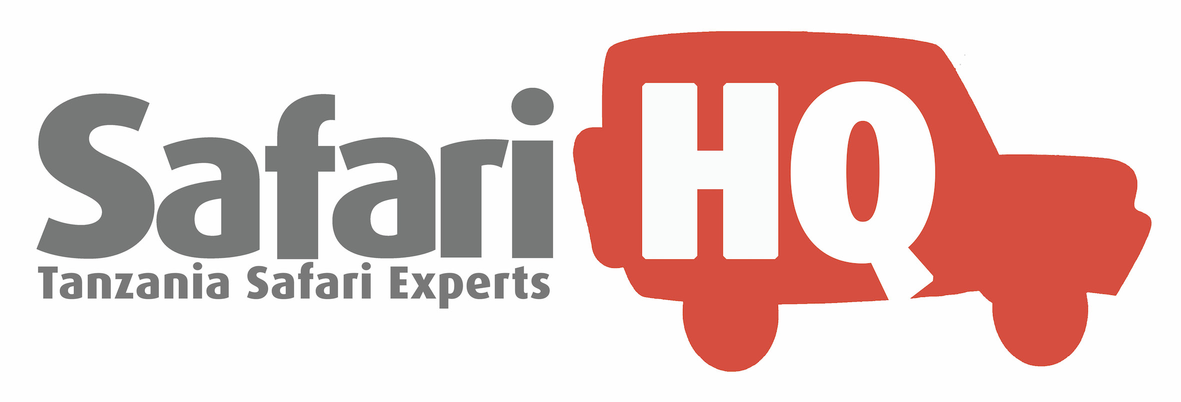Day 1: Arusha / Moshi to Machame Camp
The journey begins with a drive from Arusha or Moshi to Machame Gate (1,800 meters), where the trek officially starts. From the gate, we embark on a short walk through the picturesque Machame village, passing through lush banana and coffee farms. The trail then leads us into the dense mountain rainforest, which is the most vibrant and lush forested area on Kilimanjaro. This part of the trek is especially rich in biodiversity, and it's the primary source of 96% of the water on the mountain.
On sunny days, the forest is stunningly beautiful, with a vibrant green canopy, though it can become muddy if the weather has been rainy. Along the way, we stop for lunch at Halfway Clearing, a small opening in the forest that provides a perfect rest spot. After lunch, we continue our ascent, with the gradient gradually easing as we move into the giant heather zone, bringing us closer to Machame Camp (3,000 meters), located near the ruins of Machame Hut.
If the evening clouds cooperate, we may be treated to our first view of the majestic Kibo Glacier Dome, standing tall above us. After a rewarding day’s walk, we’ll settle in for the night at Machame Camp, ready for the adventure ahead.
Walking Time: 6-8 hours
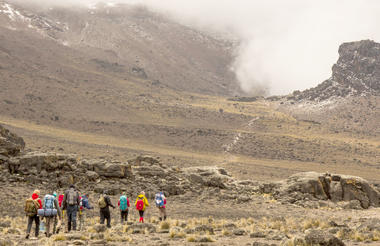
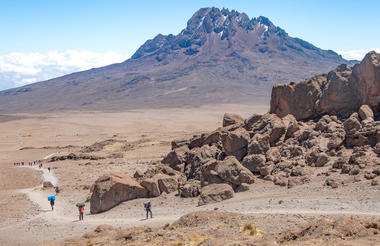
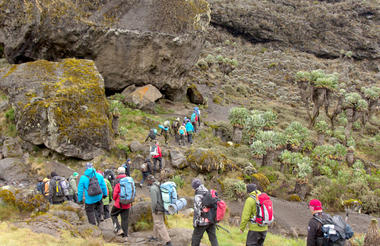
Day 2: Machame to Shira Camp (Elevation: 3,720 meters)
After breakfast at Machame Camp (3,000 meters), the day begins with a shorter but scenic trek. The trail starts by climbing a steep ridge, leading us to a small semicircular cliff known as Picnic Rock. From here, you’ll be treated to excellent views of Kibo and the jagged rim of the Shira Plateau. This is a great spot to take a break and enjoy the surroundings before continuing the climb.
The trail then becomes less steep as we continue towards the Shira Plateau (3,600 meters). As we ascend, the landscape begins to change, with the terrain becoming more open and expansive. We camp near Shira Cave Camp (3,720 meters), which is renowned for its breathtaking views. Here, you’ll be close to the huge volcanic cone of Kibo (5,895 meters), the stunning rock formations of the Shira Plateau, and across the plains, you’ll catch sight of Mt. Meru (4,566 meters) floating on the clouds.
Highlights of the Day:
Picnic Rock (3,400 meters): A perfect spot for a rest, offering panoramic views of Kibo and the Shira Plateau.
Shira Plateau (3,600 meters): As you continue the trek, the landscape becomes more open, with dramatic rock formations and wide vistas that create a sense of vastness and beauty.
Stunning Views: Shira Cave Camp (3,720 meters) offers some of the most spectacular views on Kilimanjaro, with Kibo's volcanic cone towering above, the Shira Plateau surrounding you, and Mt. Meru visible in the distance.
Walking Time: 4-6 hours
Dinner and overnight at Shira Camp, where you’ll enjoy the serene beauty of the high-altitude plateau.
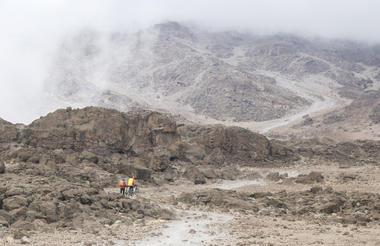
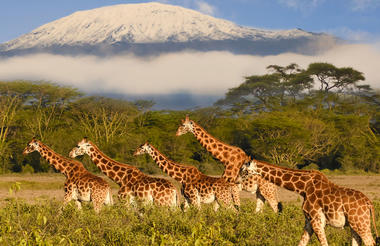
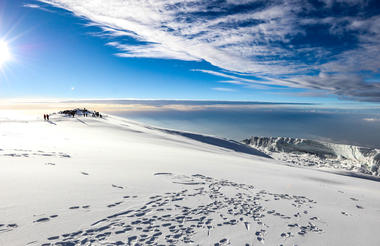
Day 3: Shira Cave Camp to Barranco Camp (Elevations: 3,900 meters)
After breakfast at Shira Cave Camp (3,720 meters), the day begins with a gentle ascent as we leave the moorland plateau behind. The trail takes us across lava ridges, offering panoramic views of the surrounding landscape and the towering glaciers of the Western Breach. The scenery is dramatic as you walk beneath the icy expanse of the glaciers, providing a unique and awe-inspiring experience.
We stop for lunch near the Lava Tower junction (4,500 meters), where the views are expansive, and the atmosphere is rugged and otherworldly. After lunch, we begin our descent into the Great Barranco Valley (3,900 meters). The valley is sheltered by towering cliffs, and we are treated to incredible views of the plains far below. The descent offers a nice change in terrain, making the day’s trek both challenging and rewarding.
Highlights of the Day:
Lava Ridges: A scenic walk across the lava ridges beneath the Western Breach, with panoramic views of the glaciers and the surrounding landscape.
Lava Tower Junction (4,500 meters): A perfect stop for lunch, where you can take in the incredible terrain and prepare for the descent into the valley.
Great Barranco Valley (3,900 meters): The descent into this sheltered valley offers dramatic views of the towering cliffs and the expansive plains below. The camp is nestled in a stunning location with panoramic vistas.
Walking Time: 5-7 hours
Dinner and overnight at Barranco Camp (3,900 meters), where you'll rest and enjoy the tranquil surroundings before continuing your journey.
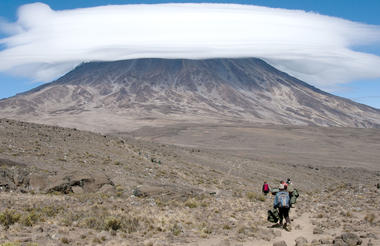
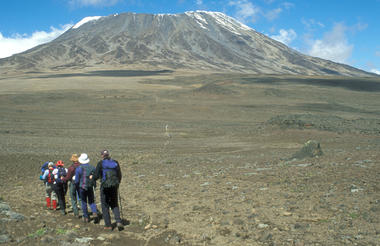
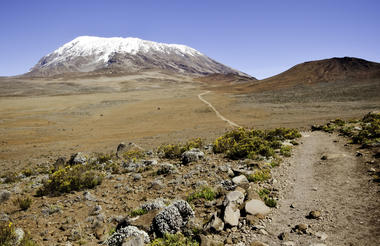
Day 4: Barranco to Karanga Camp (Elevations: 3,900 meters to 4,035 meters)
After breakfast at Barranco Camp (3,900 meters), the day begins with a steep climb up the Barranco Wall. This is one of the most thrilling parts of the trek, as you scramble up the rocky face, offering stunning panoramic views of the surrounding landscape, including the Southern Ice Fields. The climb is challenging but rewarding, providing a sense of achievement once you reach the top.
Once over the wall, the trail continues along the southeastern flank of Kibo, following an undulating path with breathtaking views of the glaciers and the rugged terrain. The scenery is truly spectacular, and this stretch of the trek offers fantastic opportunities for photos and enjoying the beauty of the mountain.
We stop for lunch at Karanga Camp (4,035 meters), which is the last water point before we continue higher. Located in a steep valley, it offers dramatic views of the mountain. After lunch, we settle into Karanga Camp for the night.
Highlights of the Day:
Barranco Wall (3,900 meters): A thrilling scramble up the Barranco Wall, with panoramic views of the mountain and surrounding landscapes.
Southeastern Flank of Kibo: After the climb, enjoy a more gradual trek along the southeastern side of Kibo, with stunning vistas of the Southern Ice Fields and glaciers.
Karanga Camp (4,035 meters): The last water point before the ascent, nestled in a beautiful and sheltered valley with magnificent views.
Walking Time: 3-5 hours
Dinner and overnight at Karanga Camp (4,035 meters), where you'll rest and prepare for the next leg of your journey.
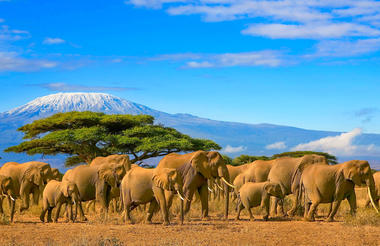


Day 5: Karanga to Barafu Camp (Elevations: 4,035 meters to 4,600 meters)
After breakfast at Karanga Camp (4,035 meters), we begin the day with a short but steep climb as we continue along the undulating trail on the southeastern flank of Kibo. Along the way, we are treated to superb vistas of the Southern Ice Fields and glaciers. This section of the trek offers incredible panoramic views and is a great spot for photography.
We then stop for lunch at Karanga, the last water point before ascending higher. The camp is located in a steep valley, providing a tranquil and sheltered spot for a rest. After lunch, the terrain changes as we leave the valley behind and ascend onto rocky scree slopes. The path becomes steeper as we climb toward Barafu Camp (4,600 meters), which we reach by mid-afternoon.
Upon arrival at Barafu Camp, we have the remainder of the day to rest and prepare for the final ascent to the summit. It’s important to conserve energy for the challenging hours ahead. The night will come early, as we aim to get as much rest as possible before the climb to the summit in the early hours of the morning.
Highlights of the Day:
Southeastern Flank of Kibo: A steady climb with stunning views of the Southern Ice Fields and the glaciers of Kibo.
Karanga Camp (4,035 meters): A peaceful lunch stop at the last water point before we continue our ascent.
Scree Terrain: The terrain changes as we ascend onto rocky scree slopes, adding a new challenge to the trek.
Barafu Camp (4,600 meters): Our camp for the night, where we rest and prepare for the final push to the summit.
Walking Time: 6-8 hours
Dinner and overnight at Barafu Camp (4,600 meters), where you’ll rest for the final ascent the next day.



Day 6: Barafu to Uhuru Peak then to Millennium Camp
(Elevations: 4,600 meters to 5,896 meters, then down to 3,950 meters)
We begin our summit ascent from Barafu Camp (4,600 meters) around 1:00 a.m., climbing by torchlight under the stars. The trail is steep and covered in loose volcanic scree, but with a steady pace and determination, we zigzag our way upwards. After about five to six hours, we reach Stella Point (5,735 meters) on the Crater Rim, just in time to witness a breathtaking sunrise over Mawenzi Peak.
From Stella Point, those feeling strong can continue for the final push along the crater rim to Uhuru Peak (5,896 meters)—the highest point in Africa. This section takes approximately two hours round-trip, passing close to the majestic glaciers and ice cliffs that crown the summit.
After soaking in your achievement, we begin our descent back to Barafu, where we’ll rest briefly and enjoy some refreshments. We then continue our descent down the mountain, leaving the alpine desert behind as we enter the upper reaches of the forest zone. Our final stop for the day is Millennium Camp (3,950 meters), nestled among heather and moorland, offering a warmer and more sheltered night after the summit.
Highlights of the Day:
Nighttime Ascent: Climb under the stars to reach the summit just in time for sunrise.
Stella Point (5,735 m): A dramatic spot on the crater rim with panoramic views and your first glimpse of the summit.
Uhuru Peak (5,896 m): The roof of Africa—an unforgettable achievement surrounded by glaciers and sky.
Descent to Millennium Camp (3,950 m): A scenic and rewarding descent through shifting ecological zones to your final camp.
Walking Time: 11–15 hours
Dinner and overnight at Millennium Camp (3,950 meters), where you’ll rest and reflect on your successful summit before your final descent.


Day 7: Millennium Camp to Mweka Gate, then Transfer to Moshi / Arusha / Kilimanjaro Airport
(Elevation: 3,950 meters to 1,650 meters)
After a well-earned rest at Millennium Camp (3,950 meters), we begin our final descent on Kilimanjaro. The trail leads us down through open moorlands, gradually transitioning into the lush montane rainforest. This part of the trek is rich with towering trees, vibrant undergrowth, and the sounds of birdlife—a beautiful way to end your journey on the mountain.
The descent is steady and sustained, taking 4–6 hours as we make our way to Mweka Gate (1,650 meters). Here, you’ll receive your summit certificates and say farewell to your mountain crew. It’s a moment to celebrate the incredible achievement of reaching Africa’s highest point.
From the gate, a vehicle will be waiting to transfer you back to your hotel in Moshi or Arusha, or directly to Kilimanjaro International Airport (JRO), depending on your departure plans.
Highlights of the Day:
Scenic Descent: A peaceful walk through shifting vegetation zones, from moorland into rainforest.
Mweka Gate (1,650 m): The end of the trail, where you'll sign out of the park and receive your official certificate.
Return Transfer: Comfortable transfer back to Moshi/Arusha or the airport for your onward journey.
Walking Time: 4–6 hours
Congratulations—you’ve completed the Machame Route and stood on the Roof of Africa!
Let me know if you'd like me to wrap up the full itinerary or format it as a single document!



